There are dozens of detailed important fishing methods that you practice and combine to produce effective bass fishing. A great fisherman must understand his prey’s behavior, what triggers each reaction, and be able to foresee triggers before they happen. Then and only then can you be an excellent bass angler.
Fortunately for you, this article has all the advanced bass fishing tips and techniques you can start implementing on your next fishing escapade to start to catch fish like a pro.
Where There Is Cover, You’ll Find Bass
Even with the best fishing rod and tastiest bait, you won’t catch any bass if you’re fishing in the wrong places. The first step in becoming an expert bass angler is understating their feeding behavior, as it most of the time, inspires their choice of location.
Bass feed on smaller fish. However, they’re not the sort of hunters that chase prey. Instead, they look for cover and ambush their prey as they pass by. This is why fishing for bass, during normal conditions, in open water is ineffective. You have to identify their hiding spots and bait them from there.
Common areas that bass use as cover include wood, rocks, boat docks, lily pads, and shallow water grass among others. Sounds easy enough, right? Guess again, bass are versatile and highly adaptable and can also use unique sources of cover to catch their prey unawares. These include hiding under riverbed sand, points where there’s a change in the type of rock, or even in open water under the shade of your kayak.
Once you’ve identified potential points that bass could be using for cover, it’s time to bait them. For better results, whether you are using livebait, swimbait, jigging, crank fishing, it’s best to give fish multiple angles to get to the bait. Begin by casting your first bait outside the cover. This is to catch any bass that may have taken an active approach to catch prey.
You should then proceed to cast bait deeper and deeper into cover. By taking this approach of casting bait from the outside to the inside, you’ll be able to catch more gamefish from each source of cover.
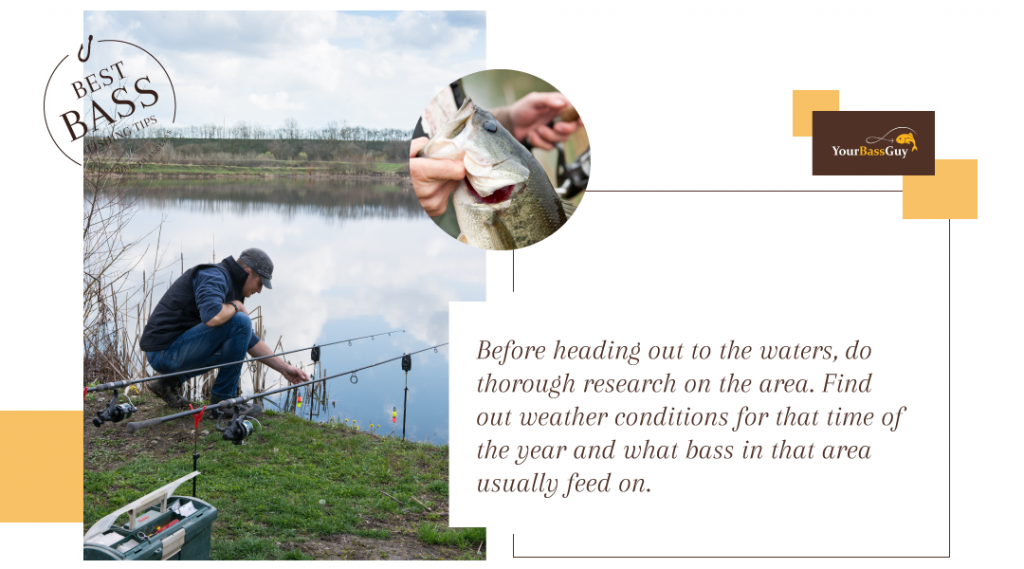
Let the Weather Be Your Guide
Bass are a highly adaptive fish species that behave according to the conditions present. In this regard, the weather is one of the conditions that significantly affect their behavior. This, in turn, determines the suitable bass angling technique. Also, weather conditions affect the effectiveness of different angling and how bait appears underwater. Therefore, the weather conditions are going to impact your strategy and approach.
Though they’re ambush hunters, bass become more active and come out to open waters when it’s cloudy and cool or at a later time of day. When it’s cloudy, bass feels more comfortable and less visible to predators, which makes it a good time to catch them. However, cloud cover calls for a slight change in strategy. In such conditions, you will have greater success with moving baits such as topwater plugs, spinnerbaits, and chatter baits. The baits you use should also be bright or have contrasting colors such as black and blue. This will get bass smacking on your baits.
It’s also crucial to be aware of weather fronts. Bass alter their behavior before and after storms or cold fronts. When there is a storm coming, barometric pressure drops. As it drops, there’s less pressure exerted on the body of water by the air above. As a result, bass requires less energy to move around, which triggers them to come out into deep water and feed. This principle is doubly true during spawning and pre-spawn seasons.
When a storm is coming, you should switch to moving baits to capitalize on this wacky feeding frenzy. After it passes, you can use still bait as bass will slow down as the barometric pressure rises. For sunny days with clear water bass fishing, locate cover and use bottom bouncing baits such as jig or Texas-rigged soft plastic. Ensure that the fishing lures you use on bright days are natural-colored.
When it comes to weather and bass fishing, it’s not about the perfect fishing weather. Excellent bass anglers are those who can adjust their approach according to weather conditions.
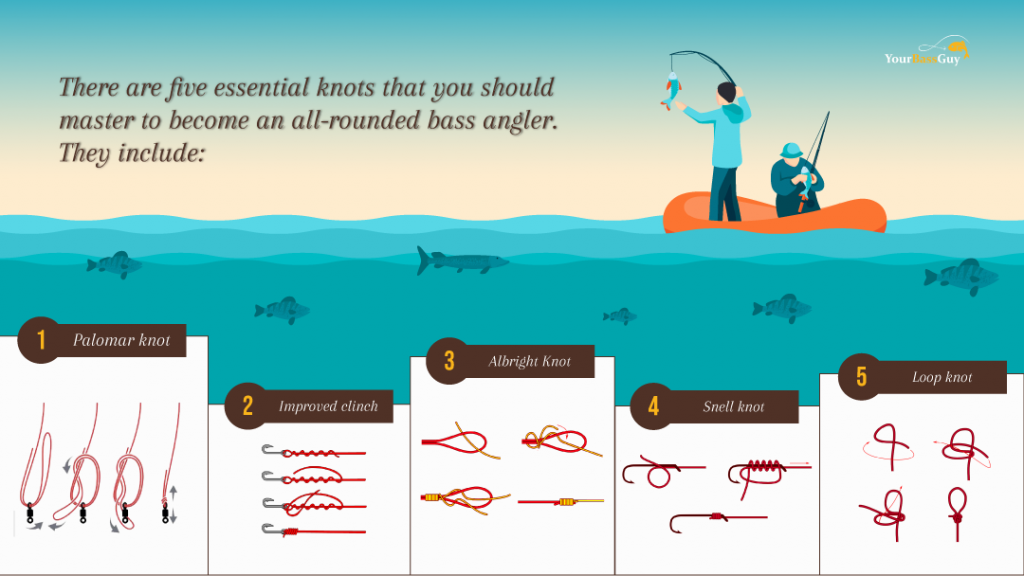
Become a Knot Master
For a bass angling aficionado, there’s no better moment than when you feel something pulling on the other side of the fishing line. However, for novice anglers, that great sensation often turns into disappointment when the catch breaks free due to a bad knot. As well as selecting the right freshwater fishing rods, lures, and reels, it’s paramount that the knots you tie are strong, or you might as well not fish.
Knots connect the lure to your fishing line, and if it fails, all your good work and patience goes down the drain. There are many different types of knots, and each is suitable for various conditions, but none is perfect for all situations. To improve your success, it’s best to transition from the old bass fisherman’s knot that has been used in your family for generations.
However, tying knots is a strenuous task, and more so while you are on the water. Nonetheless, it’s a skill that every bass angler must master. The secret here is simple. Begin by choosing a versatile knot and practice tying it until you can do it without thinking about the process. Go for knots such as clinch and palomar that can be used with a wide range of techniques.
There are five essential fishing knots that you should master to become an all-rounded bass angler. They include:
- Palomar knot
- Improved clinch
- Albright Knot
- Sell knot
- Loop knot
Once you’ve mastered the first one, move to another and perfect it.
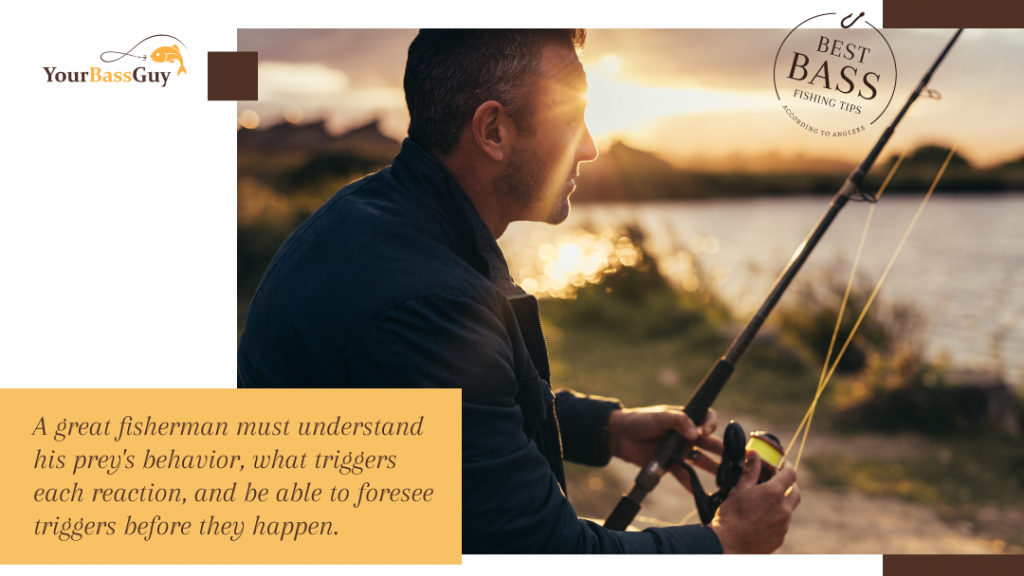
Mimic the Prey
Big bass is a fish species that prey on other fish and creatures, using bait that resembles their diet can significantly increase your success. This is one of the tips that seem straightforward but are easy to mess up if you are not detail-oriented.
Bass is a versatile species that feeds on a wide range of prey, including crappie, shad, sunfish, crawfish, worms, salamanders, snakes, frogs, and even ducklings. The main diet for bass varies from one place to the next. Therefore, to lure bass effectively, it’s time to get rid of plastic worms and start using bait that realistically mimics the prey they feed on most, in that particular location.
Crankbaits and spoons are suitable baits in areas where bass feed on shiners, shad, and other types of baitfish. When there’s little visibility, bass rely on vibrations to detect prey. During cloudy days or in muddy waters, use rattling crankbaits that create vibrations.
In areas where small minnows are their staple food, use a dropshot rig with a small plastic. If your fishing in an area that has some vegetation growth within the river or lake, bass in that region may be used to a wide variety of prey. There are also soft plastic baits that resemble frogs, crayfish, lizards, and other creatures that can come in handy in such areas.

Keep Temperature in Mind
By now, you are well aware of how bass can change behavior quickly in response to minor changes in their ecosystem. However, there are also seasonal bass behavioral changes that are triggered by changes in water temperature. In different times of the year, and depending on your fishing location, there may be significant variations in water temperature.
Bass are cold-blooded, and water temperature affects their body temperature and habits. As water temperature changes, the amount of food bass needs to eat for sustenance changes, which then affects their feeding patterns and activity levels drastically. As the water temperature lowers, the less bass needs to feed, and as it rises, the more food they need to consume.
During the colder time of year when the water temperature is really low (32 – 40 degrees), you need to get bait right where the bass is to tempt it to take a bite. That’s why it’s best to use small baits that cause minimal disturbance in the water. When the water is warm, bass are more aggressive as they need to feed more due to their increased metabolism. Topwater baits are suitable for such conditions.
However, it’s important to note that these behavioral rules are different during normal conditions when weather and water temperatures are moderate. On a day to day perspective, when the water is warm (from midmorning to afternoon), bass are less mobile, and aggressive lures work best. When it’s cooler (mornings and evenings), use slow-moving baits as bass are more active.

Learn How to Use the Wind
One of the biggest mistakes novice bass anglers make is assuming that a moderately sunny day with no winds is perfect for catching bass. Any time it becomes windy they pack up and head back. This is because fishing when the winds are at speeds of 15mph certainly isn’t a walk in the park. Winds affect casting accuracy, and keeping the boat and bait in position becomes difficult.
However, in this little chaos lies an excellent opportunity to catch smallmouth bass. The idea behind being still and remaining quiet while fishing is to avoid spooking fish. When the winds are strong, it causes a lot of disturbance to the water and can even make it muddy. Bass love such conditions and come further out as they can move around without being detected.
As the wind continues to cause disturbances on the water surface, bass become less and less cautious of movement in the water, which makes them an easier target. The key to fishing successfully when it’s windy is first changing your perception of ideal fishing conditions and being willing to get out of your comfort zone. Use the following tips to make fishing in the windless troublesome:
- Have the wind blowing to the back of your boat to
reduce battery consumption - Use a windsock or any cone-shaped canvas bag to reduce
the boat’s drift rate and keep it steady - Use heavier bass lures and tighten the cast control
knob to reduce backlashes - Cast into the wind and keep it to your back as much as
possible - Ensure your boat has a full gas tank and fully charged
batteries for safety purposes
When it’s windy, spring bass get into chasing mode. As such, you should use fast-moving baits such as crankbaits and spinnerbaits.

Have the Right Fishing Gear
When it comes to bass angling, size does matter. Catching bigger fish is usually a better fishing experience ( r, and if you fancy yourself for a challenge, there are many bass competitions that can earn you a decent sum if you’re good enough. To get to this level, you will need to invest in the right gear. This is because bass can weigh as much as 10 pounds, are highly intelligent, and do not go down easy, not to mention the other challenges of angling. As such, you need durable gear that can withstand harsh temperatures and is non-corrosive.
Fishing equipment you need in your tackle box include:
Fishing Rod
The type of fishing rod and the features it has, greatly affect your success as a bass fishing angler (check out our articles on the best St. Croix rods). In addition to durability and resistance to temperature fluctuations, it must be suitable for your reel. When a big fish starts nibbling on your line, you need to react quickly and with finesse, for this, your rod tip should be sensitive enough to allow you to pick up on minor vibrations. It’s one thing to have bass nibbling on your line and a totally different one to have a catch. It will take some time and a bit of wrestling to tire out the bass. This will only be possible if your fishing rod is comfortable to handle and does not hurt your hands.
Fishing Reel
When choosing reels, go for those made from aluminum, carbon composites or graphite. Aluminum spinning reels are strong and have a tighter grip, whereas graphite is lighter but more resistant to corrosion in saltwater. Carbon composites offer a little bit of aluminum and graphite.
Whichever brand and model you select, ensure that it does not have any loose parts that can affect its functionality under pressure. Ideally, its drag amount should be more than the weight of the bass, which is between 8 -10 pounds.
Fishing Line
There are three basic lines you can use when fishing for bass; fluorocarbon, monofilament, and braided lines. Fluorocarbon lines have high resistance to abrasion and are not easily visible in the water. When fishing in areas where there’s heavy cover and you might need to fight and tire bass for extended periods, braided lines are best. They have high resistance to abrasion, tensile strength, and do not stretch.
However, it’s possible to combine different lines, as many anglers do, to get the best features of each.
Do Your Research
In the 21st century, you do not have any excuse for not being informed. Before heading out to the waters, do thorough research on the area. Find out weather conditions for that time of the year and what bass in that area usually feed on. This is especially important if you’re going to a location for the first time. It’s the attention to such minor details that great anglers from the novices.
Be Dynamic and Persistent
However good a fishing technique is, it’s not effective in all places or at all times. And, bass is also a versatile species that change behavior depending on the weather and other factors. As such, the key to becoming a successful bass angler is being versatile. Change your fishing spot, technique, and bait, depending on the circumstances. This will ensure all your fishing trips are bountiful.
However, it is also good to trust in your strategy and resist the temptation of switching if you go for some time without a catch. Fishing can be very unpredictable. You can spend hours without catching anything then end up with a bucket load in one hour. As such, once you have taken all factors into account and identified a suitable spot, be patient, and wait for fish to take your bait.
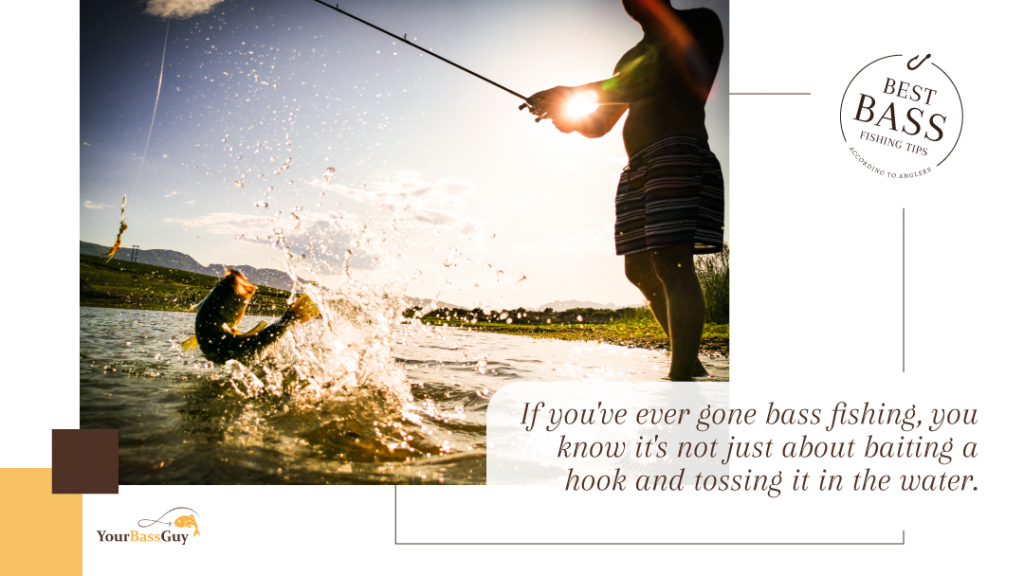
TakeAway There two key ingredients to becoming a bass angling expert. These are strategy and patience. Arm yourself with all the knowledge you need for each fishing area you visit. From this information, you will know how to fish in different conditions with different techniques. With a good strategy in place, you only need the patience to see it through. Here’s to hoping your next largemouth bass is a personal record


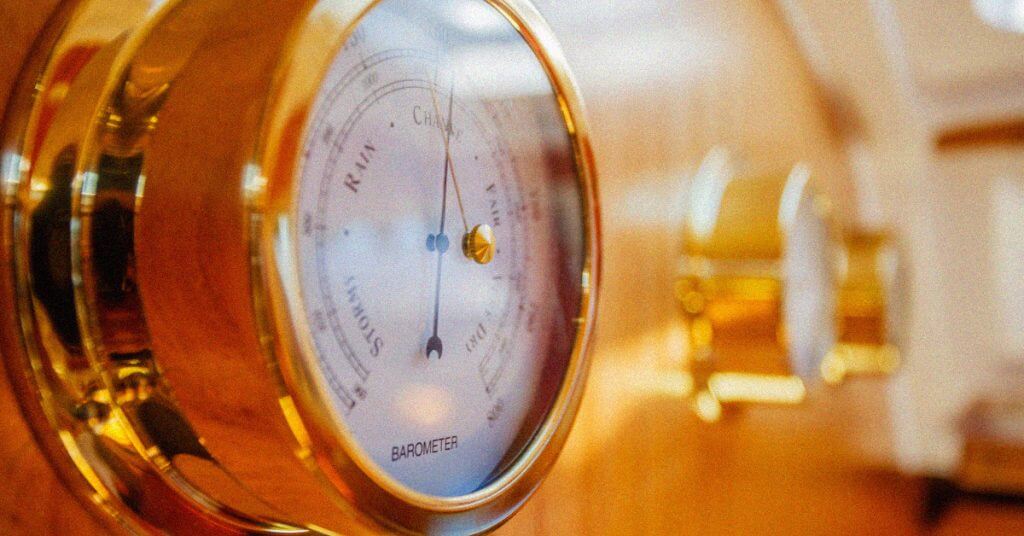
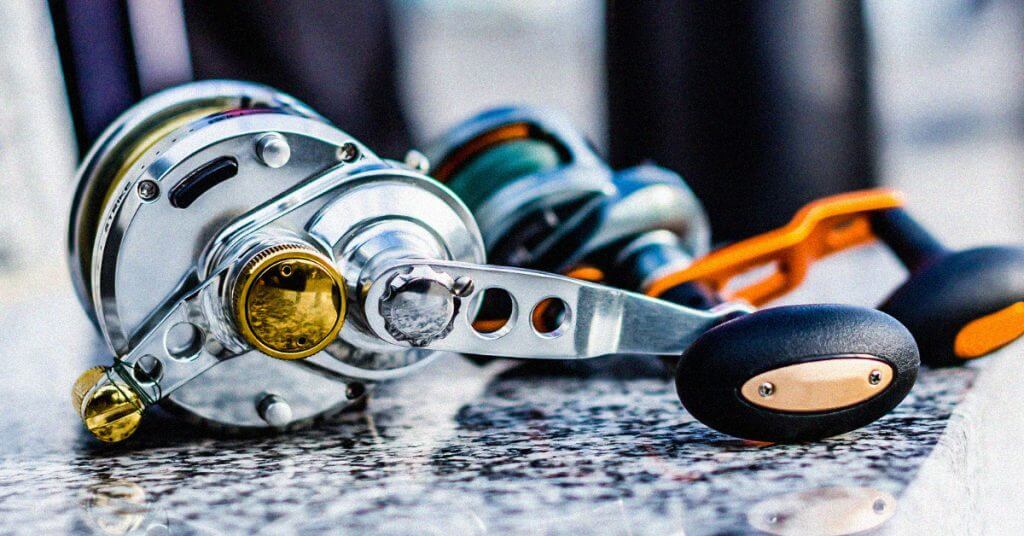
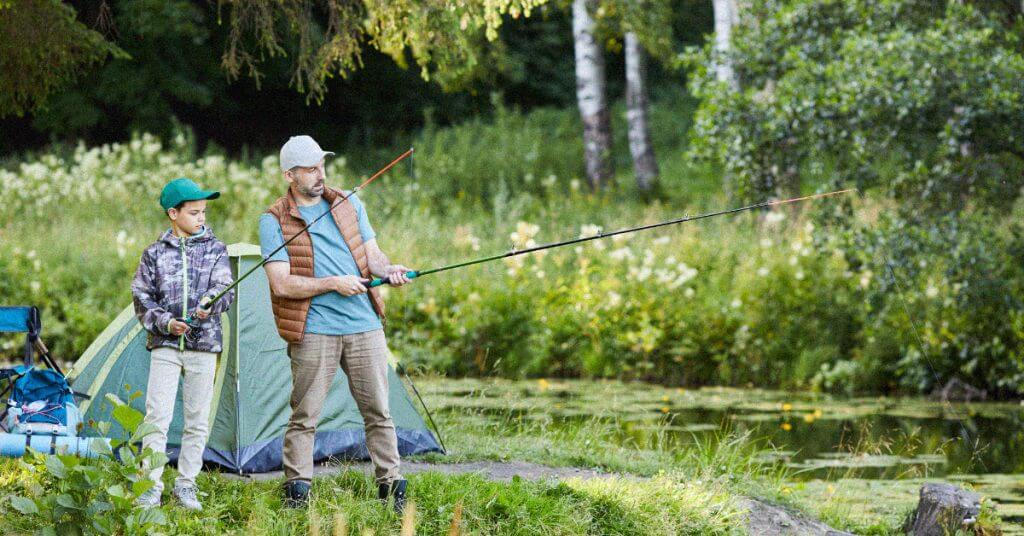
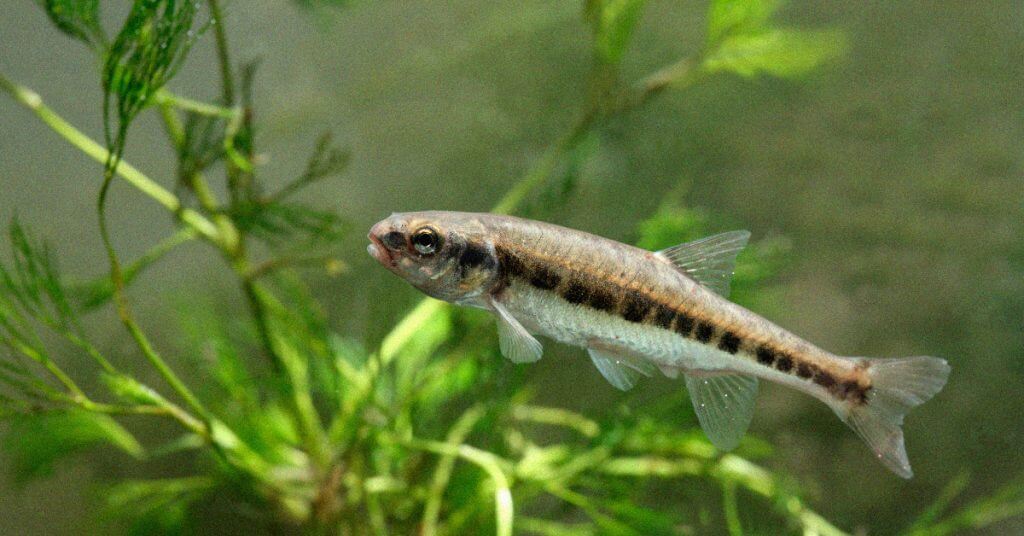
Mind blowing tips on finding a bass. The article highlights all the points required for one to really crush the bass fishing game. Thank you for the amazing tips.
Thanks for the comment and glad that you found it useful, Niladri :)
love your content, keep it up! Will hopefully share directly to all of our readers.
Thanks for stopping by and the kind words :)